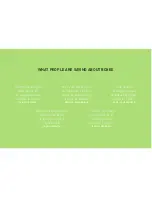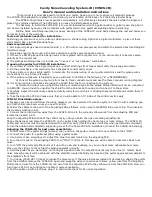
The Technical Stuff
__________________________________________________________
- 26
-
Digital Clocking Primer
Digital clocking is a complicated issue, with a number of important aspects that are often not very well
understood.
First and foremost, a digital clock is used to maintain synchronization between different digital devices.
There are two primary purposes for clock synchronization:
1.
Digital Conversion.
Analog-to-digital (A/D) conversion and digital-to-analog (D/A) conversion,
as well as sample-rate conversion (sometimes known as SRC, a function not performed by the
2192), all need extremely accurate clocking in order to correctly process the digital data.
A low-quality clock can degrade the signal in many ways, including loss of transparency, clarity,
imaging and transient response, as well as increased noise and distortion.
2.
Digital Transmission.
All digital devices need accurate clocking in order to properly transfer
digital data between interconnected devices. A low-quality clock can cause data reception errors,
which add distortion and noise, and if the clock isn’t synchronized correctly, samples may be
dropped or repeated, resulting in audible clicks or dropouts.
Clock quality is defined two ways: First, the sample rate must match the signal. This is referred to as
“sample rate synchronization.” Second, the clock signal must be stable over both short- and long-term
clocking intervals. “Jitter” refers to short-term clock accuracy, and “stability” or “drift” refers to long-term
clock accuracy. These terms are discussed in more detail below.
Sample rate synchronization is required for proper digital transmission, and is relatively easy to maintain.
Basically, there must be one and only one “clock master” for all interconnected digital devices. This is done
by setting one device to “master” mode (where it synchronizes to its internal clock and transmits that clock
signal) and setting every other device to “slave” mode (where it receives and synchronizes to external
clock), with the appropriate clock signal routed between the master and slave devices. Keep in mind that
any device, whether it’s the clock master or a slave, can send or receive data once everything is
synchronized correctly.
When doing digital conversion, it’s best to have the converter serve as the clock master. For example, if
you’re recording, clock everything off the A/D converter. Likewise, if you’re mixing, clock everything off the
D/A converter. If you’re running multiple converters, use the device with the best quality clock as master.
For all-digital transfers, e.g. a digital transfer from one DAW or storage device to another, clock
synchronization is maintained by simply setting up the proper master-slave relationship between devices.
Digital transfers can be affected by clock jitter, but not in the same way clock jitter affects analog
conversion. This is a widely misunderstood concept we’ll discuss in detail below.
Clock
jitter
is short-term variations in the edges of a clock signal, as opposed to clock
drift
, which is long-
term variations in the clock rate. A clock could be very stable over the long term, but still have jitter, and
vice versa. Timing variations are caused by noise and/or interference. If the noise/interference is a high-
frequency signal, the result is jitter, and if the noise/interference is a low-frequency signal, the result is
drift. As an analogy, a car with an out of balance wheel may drive straight, but you’ll get lots of vibration
(jitter); conversely, a car with a loose steering wheel might have a smooth ride, but it will drift all over the
road.
Clock drift affects long-term synchronization, like sound to picture, and can introduce slight pitch
variations in the audio. Usually however, the drift is so slow that these pitch variations are only tiny
fractions of a cent, and thus unnoticeable.
Clock jitter affects digital transmission and digital conversion differently, as follows:
Содержание 2192
Страница 43: ...The Technical Stuff __________________________________________________________ 39 Block Diagram ...
Страница 45: ...The Technical Stuff __________________________________________________________ 41 Frequency Response ...
Страница 50: ...Recall Sheet _______________________________________________________________________ 46 ...
Страница 54: ... This page intentionally left blank ...
















































